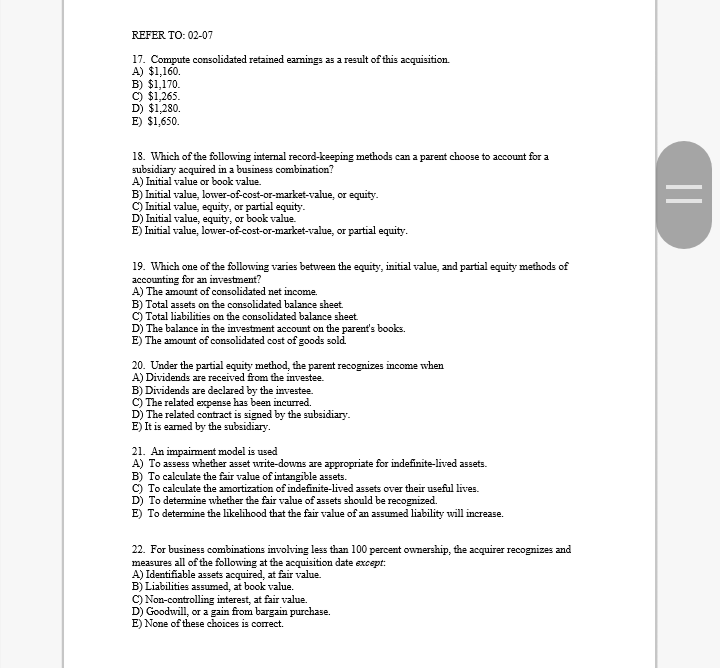
Compute consolidated retained earnings as a result of this acquisition. A) $1, 160. B) $1, 170. C) $1, 265. D) $1, 230. E) $1, 650. Which of the following internal record-keeping methods can a parent choose to account for a subsidiary acquired in a business combination? A) Initial value or book value. B) Initial value, lower-of-cost-or-market-value, or equity. C) Initial value, equity, or partial equity. D) Initial value, equity, or book value. E) Initial value, lower-of-cost-or-market-value, or partial equity. Which one of the following varies between the equity, initial value, and partial equity methods of accounting for an investment? A) The amount of consolidated net income. B) Total assets on the consolidated balance sheet C) Total liabilities on the consolidated balance sheet D) The balance in the investment account on the parent's books. E) The amount of consolidated cost of goods sold Under the partial equity method, the parent recognizes income when A) Dividends are received from the investee. B) Dividends are declared by the investee. C) The related expense has been incurred. D) The related contract is signed by the subsidiary. E) It is earned by the subsidiary. An impairment model is used A) To assess whether asset write-downs are appropriate for indefinite-lived assets. B) To calculate the fair value of intangible assets. C) To calculate the amortization of indefinite-lived assets over their useful lives. D) To determine whether the fair value of assets should be recognized. E) To determine the likelihood that the fair value of an assumed liability will increase. For business combinations involving less than 100 percent ownership, the acquirer recognizes and measures all of the following at the acquisition date except: A) Identifiable assets acquired, at fair value. B) Liabilities assumed, at book value. C) Non-controlling interest, at fair value. D) Goodwill, or a gain from bargain purchase. E) None of these choices is correct. Compute consolidated retained earnings as a result of this acquisition. A) $1, 160. B) $1, 170. C) $1, 265. D) $1, 230. E) $1, 650. Which of the following internal record-keeping methods can a parent choose to account for a subsidiary acquired in a business combination? A) Initial value or book value. B) Initial value, lower-of-cost-or-market-value, or equity. C) Initial value, equity, or partial equity. D) Initial value, equity, or book value. E) Initial value, lower-of-cost-or-market-value, or partial equity. Which one of the following varies between the equity, initial value, and partial equity methods of accounting for an investment? A) The amount of consolidated net income. B) Total assets on the consolidated balance sheet C) Total liabilities on the consolidated balance sheet D) The balance in the investment account on the parent's books. E) The amount of consolidated cost of goods sold Under the partial equity method, the parent recognizes income when A) Dividends are received from the investee. B) Dividends are declared by the investee. C) The related expense has been incurred. D) The related contract is signed by the subsidiary. E) It is earned by the subsidiary. An impairment model is used A) To assess whether asset write-downs are appropriate for indefinite-lived assets. B) To calculate the fair value of intangible assets. C) To calculate the amortization of indefinite-lived assets over their useful lives. D) To determine whether the fair value of assets should be recognized. E) To determine the likelihood that the fair value of an assumed liability will increase. For business combinations involving less than 100 percent ownership, the acquirer recognizes and measures all of the following at the acquisition date except: A) Identifiable assets acquired, at fair value. B) Liabilities assumed, at book value. C) Non-controlling interest, at fair value. D) Goodwill, or a gain from bargain purchase. E) None of these choices is correct







